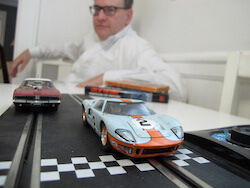The new feature film Ford v. Ferrari, starring Matt Damon and Christian Bale, recreates Henry Ford II’s scheme to reinvent the Ford company while simultaneously avenging a bitter rivalry between himself and Enzo Ferrari. Adhering closely to A.J. Baime’s 2009 book Go Like Hell, the movie chronicles the Ford Motor Company’s outrageous pursuit of designing, building, and racing a car that could beat Ferrari at the 24 Hours of Le Mans, the most prestigious and brutal race in the world.
Initially the herculean task was assigned to Ford's Advanced Vehicles Group in the U.K., but the team couldn’t figure out how to make the first batch of GT40s stay firmly on the tarmac nor run continuously for 24 hours. After consecutive losses to Ferrari at Le Mans in 1964 and 1965, Ford enlisted legendary Los Angeles car designer Carroll Shelby—one of the only American drivers to ever win at Le Mans—to run race operations. Rather than starting from scratch, Shelby and his go-to test driver and engineering specialist Ken Miles collaborated with Advanced Vehicle Group and Ford's experimental engine group to reinvent the GT40.
As a native Detroiter who sees the world through a lens of systems thinking, I couldn’t help but watch the film (twice) with process improvement in mind. Here are three business lessons that Ford v. Ferrari demonstrates with historical accuracy and a touch of Hollywood flair.
Lesson 1: Don’t adopt new tech until you know what problem you are trying to solve
In racing, understanding aerodynamic resistance is key. The better a car cuts through the air, the less power and fuel is required. Optimizing aerodynamics can also prevent undesired lift forces, increasing stability at high speeds. To test the aerodynamics of the GT40 prototype, the original Ford engineers put a large, heavy computer with attached sensors into the car. The Shelby team ripped out the computer and instead taped strings over the surface of the car, then observed the exterior of the car to see how air traveled over and around the vehicle. Often the best model of the system is the system itself.
Another takeaway from this example is that the strings make the issue observable, which is something we discuss at length in my MIT Sloan Executive Education program. Unlike a computer printout, the streamers provided direct and immediate visual measurement of the entire system. Indeed, the very presence of the computer in the car distorted the performance of the system, as it significantly increased the weight of the car. How many times have we witnessed a new technology producing the exact opposite of its intended effect? From Roger Smith’s “Lights Out” factory to Elon Musk’s flirtation with excess automation at the Tesla facility, the “shiny new toy” technology fallacy seems to be one mistake most companies will continue repeating.
Lesson 2: Flatten your decision making
In the movie, Ford’s decision on the Shelby program went through the classic “15 middle managers,” visualized by a red folder circulating the Glass House (Ford’s Dearborn headquarters). The red folder is the perfect analogy the “hidden factory” of middle management. (A “hidden factory” is any activity or set of activities that reduce the quality or efficiency of operations but are not initially known to managers or others seeking to improve the process.) Shelby eventually shortens the feedback loop by insisting he report directly to Henry Ford II. Similarly, organizations should flatten decision making as much as possible to ensure that decision makers have actually seen what’s in the folder. Paraphrasing a conversation I once had with Jay Forrester, the Father of System Dynamics, the purpose of middle management seems to be to turn the message 180 degrees while adding a time delay – the absolutely optimal way to destroy the performance of any system.
Lesson 3: Go learn from others
In the Daytona race, Shelby bet his company to the Ford Motor Company on his driver, Ken Miles, winning—even against another Ford team in the race. Meanwhile, the Shelby team observed that the second Ford team in the next pit bay was having much faster pit stops. Shelby discovered they were utilizing NASCAR pit crew members. The lesson here is simple: look outside your own team, company, and/or industry for better ways of doing what you’re doing.
There are a great many parallels between business and racing, from the importance of your team, the capital required, significant investments in technology, and the goal of winning in a short period of time. If anything slows you down, you will lose. Spoiler alert—in the case of Ford, all their hard work and lessons learned paid off. The GT40 MK II defeated Ferrari at Le Mans in ‘66, capturing first, second and third places. And they won again the following year.
John Carrier is a Senior Lecturer of System Dynamics at the MIT Sloan School of Management. He instructs senior managers on improving manufacturing and business processes and serves as an on-site coach in support of projects. His research focuses on strategic marketing and new business development in high technology, specialty chemicals, and service segments.
Carrier leads the MIT Sloan Executive Education program Implementing Industry 4.0: Leading Change in Manufacturing and Operations, a two-day program designed to help executives implement large scale technological change. He also teaches in the F1 Extreme Innovation series, a collaboration between Formula One and MIT Sloan Executive Education.








